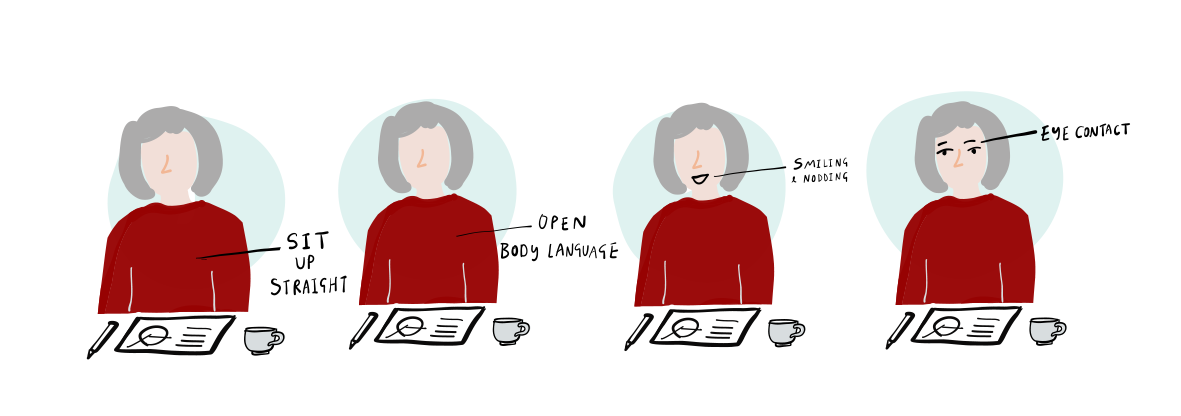How to Perfect Your Body Language in Virtual Meetings

Perfecting your body language on Zoom, Teams, Google Meet or other virtual meeting platforms (like the one we use to host our Career Navig8r mentoring sessions!) is more important than ever in today’s hybrid working world. Gone are the days of six-hour round trips for a 45-minute presentation (phew) or having to delay important meetings because the travel logistics aren’t physically possible.
From video job interviews to virtual coffees with new colleagues to online mentoring chats, so many of our communications now take place via video conferencing tools and these can be just as effective as face-to-face interactions. But for this to be the case, you need to make sure your virtual body language is on point. Read on to explore the importance of body language in virtual meetings, and discover how you can master yours.
What Does Your Virtual Body Language Look Like?
Are you aware of how you come across on video calls? It might not be something you’ve considered before, but you shouldn’t underestimate the importance of your virtual meeting body language.
Spend some time thinking about your eye contact, gestures, posture and even your tone of voice. It can be tricky to do this without feeling self-conscious or unnatural, so consider joining a video call with a friend or contact who you trust to critique your body language.
Alternatively, record yourself in your next online meeting, presentation or pitch, and watch yourself back. We know this can be painful, and you’re guaranteed to cringe/feel horrified/want to run away from yourself at least once, but it can be incredibly valuable to see how you come across.
You’ll notice little habits you didn’t realise you had and you’ll be able to see exactly what you need to work on. Remember, practice makes perfect, so repeat the process every now and again, and make a conscious effort to improve your virtual body language. It’s an ongoing journey that’ll evolve as the way we communicate continues to change too.
The Importance of Body Language in Virtual Meetings
Our virtual body language carries a different level of importance than our body language in face-to-face interactions. For example, gestures may need to be exaggerated more and the way you hold eye contact will be completely different; you’ll naturally know where to look when presenting to a room, but you may need to look directly into your webcam when on a virtual call (rather than at the very distracting small clip of your own face in the corner of the screen!).
There’s actually something that’s known as the 7-38-55 rule, which explains the importance of body language in virtual meetings (and other situations). This theory was developed by Professor Albert Mehrabian in the 1960s and it refers to the idea that our non-verbal communication (such as our body language) is significantly more important than the actual words we speak. The theory suggests that:
- 55% of all our communication is delivered by our body language, such as gestures and facial expressions
- 38% of our communication comes from other non-verbal factors like tone of voice and the volume we speak at
- 7%, the smallest percentage by far, of our communication comes from the words we say. This demonstrates why getting your virtual meeting body language right is so essential!
During mentoring sessions, non-verbal factors could be the crucial difference between your mentee feeling criticised and downhearted, or motivated and confident.
5 Ways to Improve Your Virtual Body Language
Body language in virtual meetings includes everything from your gaze to your posture and from your facial expressions to what you do with your hands. Here are 5 things to think about to improve your virtual body language:
1. Think About Your Gaze
Eye contact is crucial to building trust. Think about exactly where you’re looking on the screen during any virtual calls. Holding eye contact (it’s okay to blink occasionally) shows that you’re listening, that you respect the other person and that you’re interested in them. These factors are essential for fostering a productive, understanding mentoring partnership.
2. Consider Your Hands
It’s fine to use your hands when you’re talking to emphasise what you’re saying – just be mindful of how you’re using them. For instance, pointing can feel rude or aggressive, and bear in mind that it’s not always easy to see what your hands are doing when you’re communicating screen-to-screen. Try to position your camera so your mentee can see your hands as well as your face.
3. Keep Your Facial Expressions In Check
Your face is your representative in virtual meetings. Make a conscious effort to turn frowns upside down and try not to bite your lip (a classic sign of uncertainty, even if it’s just a nervous habit for you), and be mindful of your resting face.
4. Be Mindful of Your Gestures
Gestures can make or break your virtual body language. Pointing, waving your hands around, nodding or shaking your head…all of these gestures can add emphasis to what you’re saying – sometimes good, sometimes bad, so be careful.
5. Don’t Forget Your Posture
Posture is also a key part of your body language in virtual meetings. It can show how engaged you are and it can express everything from disinterest to inspiration, depending on how you position yourself.
Sit up straight, shoulders back – as your teachers and parents spent years telling you, don’t slouch!
Why Virtual Body Language is Important in Online Mentoring
Trust needs to be at the heart of every mentor-mentee relationship, and non-verbal factors can really help to build and cement this in your mentoring partnership. Your virtual body language will be a key part of this during your sessions.
Virtual Body Language Tips for Mentors
As a mentor, your body language in virtual meetings is important for helping your mentee feel comfortable and inspired, and for creating a safe space where they can open up about their goals. Perfecting your virtual body language is a key part of learning how to be a good mentor. Our top tips are:
- Hold eye contact – look directly at your mentee during your sessions to show that you’re actively listening to what they’re saying. This demonstrates your respect, that you’re interested and that you value everything they’re telling you
- Move your head – nodding or tilting your head to one side can show engagement when your mentee is speaking. This is a simple way to show understanding when you’re communicating virtually
- Keep your hands open – if your mentee can see your entire top half, including your hands on the desk, try to keep them unclasped with your palms facing upwards when they’re in sight. This can subconsciously signal to your mentee that you’re open to new ideas
- Try not to point – although you might be doing this simply to hammer home a point, it can come across as rude and aggressive. Whenever you’re using your hands to emphasise a point, make sure they can be seen within your webcam’s range
- Widen your eyes – doing this every now and again is a great virtual meeting body language trick, especially when accompanied by a nod or a smile. Widening the eyes can show approval or surprise, so can be an effective way to let your mentee know you’re impressed with them or that they’ve made a good point
- Watch your mentee’s eyebrows – when someone raises their eyebrows while speaking, this can be an unconscious sign that they’re seeking approval, so look out for this and respond accordingly
- Sit up straight – ideally in a space that’s free from distractions. Blur a busy background to show that you’re giving the session your full, undivided attention
Virtual Body Language Tips for Mentees
Considering your virtual body language is an important aspect of learning how to be a good mentee when your sessions take place online. Our top body language tips for mentees include:
- Maintain eye contact – look at your mentor while they’re speaking to show that you’re engaged and listening to what they’re saying
- Angle your screen carefully – it’s okay to look away from the screen if you’re taking notes. Consider angling the screen so your pen is visible, so it’s clear when you’re writing something down
- Nod while your mentor is speaking – this small virtual body language gesture shows that you understand or agree with what your mentor is saying. Ask questions if you don’t
- Don’t cross your arms – this can signal resistance, even if you don’t intend it to
- Uncross your legs – although your mentor probably can’t see them during your session, make an effort to keep them uncrossed during your session so you aren’t unconsciously closed off to advice or new ideas
- Try not to frown – if you’re unsure of what your mentor is saying, ask for clarification or explain why you’re feeling uncomfortable with their suggestion so you can understand each other better. Read more about how to take feedback on board constructively
- Sit upright – this shows you’re taking the session seriously. It might be taking place outside of your usual working hours, but your mentor doesn’t want to see you slumped on the sofa
- Avoid nervous habits – try not to play with your hair, bite your nails or anything similar. If you’re a natural fidgeter and need something to play with to help you concentrate, explain this to your mentor so they understand and don’t wrongly assume you’re distracted
- Don’t forget to smile – mentoring will leave you feeling inspired, supported and motivated, so let that show on your face. Your mentor will love to see it
Start Your Online Mentoring Journey
Whether you want to guide others in their careers or you’re the one who’s looking for guidance, sign up to Career Navig8r to start your online mentoring journey.
Our virtual mentoring platform is seriously easy to use:
- Create a mentor profile to top up your income while working from home
- Find a mentor with the skills and experience you want insight into
- Get to know each other in a 20-minute discovery call to check you’re a good fit
- Schedule regular virtual catch-ups to set mentoring goals, work through challenges and share successes
Remember our virtual meeting body language top tips and you’ll be well on your way to mentoring success!


